‘I think Fowey means more to me than anything now. The river, the harbour, the sea. It’s much more than love for a person.’
‘All I want to be is at Fowey. Nothing and no one else. This now is my life.’
The inspiration for this walk…Rebecca
I must admit it was the 1940 Hitchcock film rather than the book that first inspired me, starring Joan Fontaine and Laurence Olivier, a very intense and brooding film throughout.
I only bought the book recently on a family holiday to Fowey. I found it in Shire Books on the main drag, run by Kate, a very engaging and committed owner who had only just opened before Lockdown but had serendipitously found that the change in circumstances had done her no harm – along with bad weather, being forced indoors by restrictions was the thing most likely to make one pick up a novel. She hopes that Fowey’s voracious reading habits will continue long after COVID has abated!
KEY DATA
Walk 1: Pont Pill walk
- Terrain: Coastal hill ups and downs
- Starting point: The Haven, Esplanade, PL23 1HZ
- Distance: 6.2 km (3.9 miles)
- Walking time: 1hr 56 mins (excluding time for ferries)
- OS Map: OS Explorer 107. This route can be found online at: https://osmaps.ordnancesurvey.co.uk/route/9820101/Fowey-Pont-Pill-Hall-walk
- Facilities: Fowey & Polruan
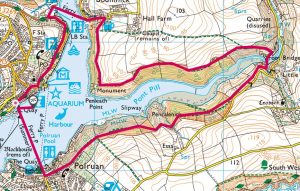
Walk 2: Menabilly & Polkerris walk
- Terrain: Coastal path ups and downs
- Starting point: Readymoney Cove, PL23 1JH
- Distance: 10.1 kms (6.3 miles)
- Walking time: 3 hours 24 mins
- OS Map: OS Explorer 107. This route can be found online at: https://osmaps.ordnancesurvey.co.uk/route/9573233/Fowey-Menabilly-Polkerris-walk
- Facilities: Fowey & Polkerris
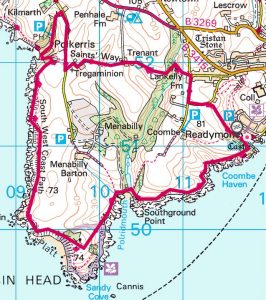
DAPHNE DU MAURIER (1907-1989)
The du Mauriers visited Cornwall for holidays throughout Daphne’s childhood, and when she was nineteen the family decided to buy a second home there. They discovered Ferryside, a former boat-building shed alongside the jetty at Bodinnick.
Daphne wrote: ‘There was a smell in the air of tar and rope and rusted chain, a smell of tidal water. Down harbour, around the point, was open sea. Here was the freedom I desired, long sought-for, not yet known. Freedom to write, to walk, to wander, freedom to climb hills, to pull a boat, to be alone.’
In 1928 she finally persuaded her parents to let her stay at Ferryside on her own through the autumn after the family headed back to London. She started to write her first novel, ‘The Loving Spirit’, seated at the window with a rug around her knees. The wild weather seemed apt for her seafaring story about the Jane Slade, which had been built in Polruan in 1870 by Christopher Slade.
Daphne had researched the history of the ship and the lives of the Slade family. This became the routine for all her novels, delving into local history and doing lots of research. Daphne seemed to derive as much pleasure from the research as from the actual writing of the novel:
‘I walked this land with a dreamer’s freedom and a waking man’s perception – places, houses, whispered to me their secrets and shared with me their sorrows and their joys. And in return, I gave them something of myself, a few of my novels passing into the folk-lore of this ancient place.’
She typically wrote in the mornings, and after lunch would walk or row her boat until four o’clock, exploring. Then she wrote for another three hours before dinner. Her observations and the nuances of the places that she knew so well became part of her novels so that when she wrote, she used these details. ‘I for this, and this for me’.
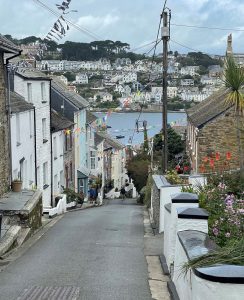
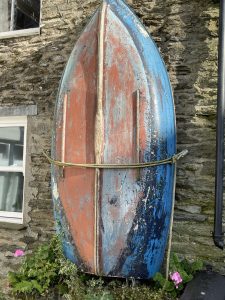
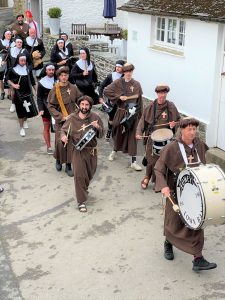
We spent a week in Polruan and experienced much of the magic of the walks that Daphne regularly took, but also the unique personality of the Cornish people – lively, naturally curious, life-embracing and always with ‘one ‘foot in the sea’. From our little cottage on the street that descended to Polruan harbour, we watched every manner of small vessel being towed up and down, fisherman heading out at first light, the Fowey Town Band noisily coming back from the pub in regatta week and youngsters dripping wet having just been jumping off the harbour wall. Oh, and the tiny Polperro bus and the binmen having always to reverse back uphill because there is nowhere to turn on the quay without the risk of going to the bottom of the harbour. All to the tune of ever-noisy seagulls on the lookout for a food spill or an unattended bin.
WALK 1: THE PONT PILL WALK
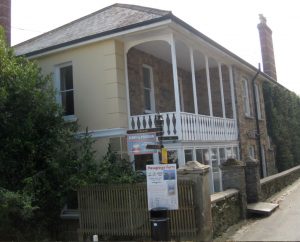 We start at the Haven and walk north through this charming port and fishing town.
We start at the Haven and walk north through this charming port and fishing town.
Sir Arthur Quiller-Couch (‘Q’: more about him later) lived at the Haven with his daughter Foy. You can imagine them welcoming their friend Daphne from the balcony. This friendship was particularly important to Daphne who often enjoyed Sunday evening supper with them here, on her day off from writing. Q encouraged Daphne’s writing and his daughter Foy became a life-long friend.
We continue along the Esplanade, and head down to Market Square with The Ship Inn on our left, a former merchant’s house owned by the Rashleigh family. In Frenchman’s Creek, the heroine Dona, dressed as a cabin boy, knocks on the front door to summon Rashleigh to his ship in Fowey Haven.
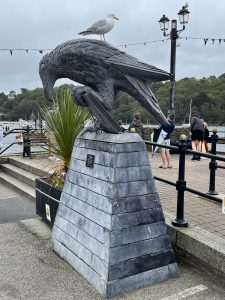 On the Town Quay, we admire a huge metal bird sculpture called ‘Rook with a Book’ erected in 2018 to commemorate du Maurier. It reminds us of course that she was the author of the short story ‘The Birds’ that formed the basis for Alfred Hitchcock’s famous film The Birds.
On the Town Quay, we admire a huge metal bird sculpture called ‘Rook with a Book’ erected in 2018 to commemorate du Maurier. It reminds us of course that she was the author of the short story ‘The Birds’ that formed the basis for Alfred Hitchcock’s famous film The Birds.
We pause at St Fimbarrus Church, which is featured in the novel My Cousin Rachel. ‘Can you imagine: Philip is worshipping here, while Rachel is having her secret assignation with Rainaldi in the back room of the pub next door,’ says Lynn. Q is also buried here.
Bodinnick
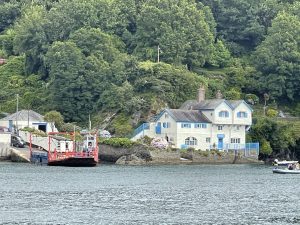
We cross on the ferry to Bodinnick and to the right of the jetty spot Ferryside, where Daphne’s son still lives. This is where du Maurier spent her summers from 1926 until 1943 and, as well as ‘The Loving Spirit’, wrote ‘Jamaica Inn’, ‘Rebecca’ and ‘Frenchman’s Creek’ here.
 We see a figurehead hanging from a beam below what used to be Daphne’s bedroom window. This is the figurehead from ‘The Loving Spirit’:
We see a figurehead hanging from a beam below what used to be Daphne’s bedroom window. This is the figurehead from ‘The Loving Spirit’:
‘Placed against the beam is the figurehead of a ship. She leans beyond them all, a little white figure with her hands at her breast, her chin in the air, her eyes gazing towards the sea. High above the clustered houses and the grey harbour waters of Plyn, the loving spirit smiles and is free.’
Ernie Slade had retrieved it from the mudflats in Pont Creek when the stranded boat was broken up and given it to Daphne.
Q Memorial
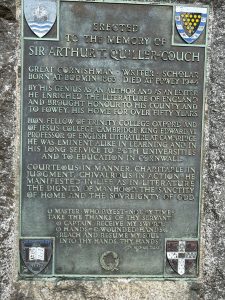 We enjoy a panoramic view of the harbour from the Q Memorial.
We enjoy a panoramic view of the harbour from the Q Memorial.
Sir Arthur Quiller-Couch published many novels, including ‘Troy Town’, a novel about a barely disguised Fowey, but he is perhaps best known for first publishing the ‘Oxford Book of English Verse’. In 1912 he was appointed Professor of English Literature at Cambridge, where one of his pupils was FR Leavis.
In Fowey, he befriended and supported many budding writers, amongst them Kenneth Grahame, JM Barrie, and of course Daphne du Maurier. ‘The critics will never forgive you for writing Rebecca,’ he had warned her with a rueful smile when it was released to popular adoration yet scathing critical reception.
Our path winds through Penleath woods, running alongside the Pont Pill river where Daphne had first spotted the wreck of the Jane Slade.
Pont Pill and Lanteglos (St Wyllow) Church
Pont Pill was at one time a busy little harbour but over the years has silted up and can now only be reached on high tides. 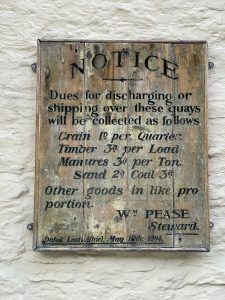 Pont Pill is thought by many local people to be part of the inspiration for Mole, Ratty, Toad and Badger’s adventures in ‘The Wind in the Willows’ because author Kenneth Grahame holidayed in nearby Lerryn. Leo Walmsley (1892–1966) wrote several novels while living in a hut by the creek, and he and Daphne became friendly. The creek is the setting for his autobiographical novel ‘Love in the Sun’.
Pont Pill is thought by many local people to be part of the inspiration for Mole, Ratty, Toad and Badger’s adventures in ‘The Wind in the Willows’ because author Kenneth Grahame holidayed in nearby Lerryn. Leo Walmsley (1892–1966) wrote several novels while living in a hut by the creek, and he and Daphne became friendly. The creek is the setting for his autobiographical novel ‘Love in the Sun’.
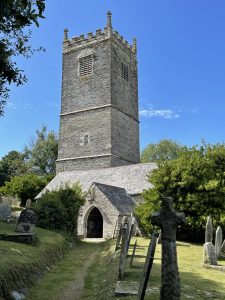 In the church at the top of the hill, we find the gravestone of Christopher Slade and Jane Slade, who were both married and buried here.
In the church at the top of the hill, we find the gravestone of Christopher Slade and Jane Slade, who were both married and buried here.
This was also the church where Daphne du Maurier was married to Major Frederick Browning in 1932 after a romance fit for fiction. He had read the ‘Loving Spirit’ and been so enthralled by it that he set off in search of the author, travelling along the coast on his motorboat Ygdrasil until he found her. He sent her a note – ‘I wondered if you would care to come out in my boat?’ – and three months later they were married here. Naturally, they arrived for the ceremony by boat, very early in order to catch the tide, and walked up to the church as we have from Pont. Daphne described the route we are taking – ‘The sun shone, casting thick shadows on one side of the lane, the hedgerows were thick with wild roses and dark, scented honeysuckle.’ I can’t imagine she was wearing her wedding dress with a long train at this point though, as the route up is steep and often muddy as a little stream runs alongside it!
Polruan (‘Plyn’)
 We arrive through the ancient ‘Truan’ woods with its rustling trees to the village of Polruan with its fabulous views across to Fowey.
We arrive through the ancient ‘Truan’ woods with its rustling trees to the village of Polruan with its fabulous views across to Fowey.
Daphne vividly describes it in ‘The Loving Spirit’: ‘Joseph felt the longing rise in his heart for Plyn. He wanted to look upon the quiet waters of the harbour, and the little cottages clustered about the hill, with the blue smoke curling from their crooked chimneys. He wanted to feel the cobbled stones of the old slip beneath his feet, where the nets were spread to dry in the sun, and where the blue-jerseyed fishermen leaned against the harbour wall. He wanted to hear the sound of the waves, splashing against the rocks below the Castle ruins, and the rustle of the trees in Truan woods, the movement of sheep and cattle in the hushed fields, the stirring of a rabbit in the high hedges that bordered the twisting lanes. He longed once more for the faces of simple folk, for the white wings of the crying gulls, and the call of the bells from Lanoc Church.’
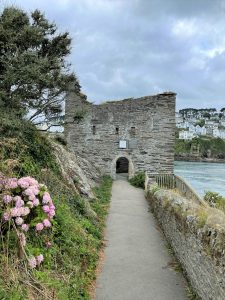 Before she began ‘Loving Spirit’, Daphne had walked up to Polruan’s blockhouse fortification on a night when the moon was high, and there was only the sound of water lapping the rocks:
Before she began ‘Loving Spirit’, Daphne had walked up to Polruan’s blockhouse fortification on a night when the moon was high, and there was only the sound of water lapping the rocks:
‘It seemed to me that I was standing on the cliffs years hence with a grown-up son. I was a ghost, long dead, existing only in his thoughts. And from that I passed on to thinking about my unborn book. My thoughts were of a past and future no longer separated in time, and I knew it must be the story of four generations.’
We finish our walk by walking up to the Blockhouse and surveying Fowey and its harbour full of brightly coloured sailing boats.
WALK 2: MENABILLY & POLKERRIS WALK
We take the ferry back to The Haven, and this time we head southwest along the coast path in search of Manderley.
Readymoney Cove
Daphne became a permanent resident of Fowey in 1942 when she rented Readymoney Cottage by Readymoney Cove for a year with her three children.
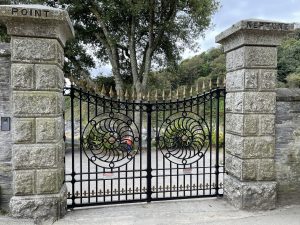 It was the former coach house to Point Neptune, a grand 40-bed Italianate mansion across the road. When we look up at Point Neptune’s gates, we catch our breath, for anyone who’s read the famous first paragraph of ‘Rebecca’ will know exactly what we are looking at:
It was the former coach house to Point Neptune, a grand 40-bed Italianate mansion across the road. When we look up at Point Neptune’s gates, we catch our breath, for anyone who’s read the famous first paragraph of ‘Rebecca’ will know exactly what we are looking at:
‘Last night I dreamt I went to Manderley again. It seemed to me I stood by the iron gate leading to the drive, and for a while I could not enter, for the way was barred to me. There was a padlock and chain upon the gate. I called in my dream to the lodge keeper, and had no answer, and peering closer through the rusted spokes of the gate I saw that the lodge was uninhabited.’
But how come, this definitely isn’t Menabilly (‘Manderley’), which is a couple of miles further along the coast. A quick piece of research (Daphne would have been proud of me) reveals that these gates were indeed once at the entrance to Menabilly but that they had been taken down and re-erected by the Rashleighs at this property, which they also owned.
Polridmouth Cove (pronounced Pridmouth)
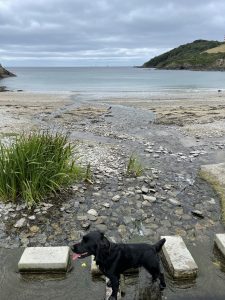
This is the famous cove in ‘Rebecca’, with Polridmouth Cottage by the pond, the inspiration for the boathouse in the novel. On the southern side of the bay, we see the partially submerged metal remains of the wrecked ship Romanie at low tide, sunk in 1930, which inspired the idea for Rebecca’s demise.
Menabilly (‘Manderley’)
Looking up from the beach, we glimpse a path that winds up through the woods to ‘Manderley’. The house, surrounded by trees, remains as elusive today as it was when du Maurier first tried to find it herself.
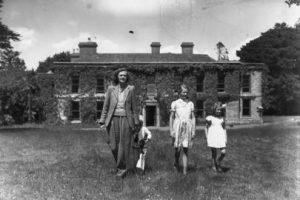
“In the distance below us stretched the sea. Behind us the woods and the valley through which we had come. But nowhere was there a sign of any house. Nowhere at all. ‘Perhaps’, I thought to myself, ‘it is a house of secrets, and has no wish to be disturbed.’
She had discovered the house years earlier on one of her walks, and she became fascinated by the place, a grand deserted Georgian house in a dilapidated state, owned but totally neglected by the Rashleigh estate. She eventually persuaded them to rent it to her and she lived here with her family for over 25 years, from 1943 to 1969.
Her favourite hideaway was a gardener’s hut, where, she said, ‘I’d sit for hours on end, chain-smoking, chewing mints and tapping away at my typewriter.’ ‘It’s ideal’, she wrote to a friend. ‘It’s at the end of the stretch of grass here, that looks down at the far end at the sea…curiously enough, it’s just a few yards from the place I’ve always wanted to be buried.’
Gribbin Tower
We climb up to Gribbin Tower, an almost daily walk for Daphne with her Yorkshire terriers when she lived at Menabilly – she must have become pretty fit!
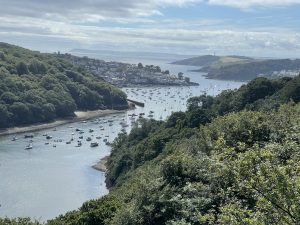
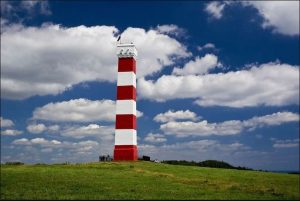
Erected by Trinity House in 1832 ‘for the safety of commerce and the preservation of mariners’, the tower pinpoints the approach to Fowey’s narrow and rocky harbour entrance. This meant that sailors did not mistake the treacherous shallows of St Austell Bay for the deep waters of Falmouth Harbour.
William Rashleigh of Menabilly, who granted the land for the tower, expressed his hope that they would ‘make the Beacon an ornament to my grounds’; thus the tenders issued by Trinity House were for the erection of a ‘very handsome Greco Gothic Square Tower’.
It was near here, as we walk along the cliffs to Polkerris, that Du Maurier saw a flock of seagulls circling and diving around a man ploughing a field, an incident which inspired her story ‘The Birds’:
‘What he had thought at first to be the white caps of the waves were gulls. Hundreds, thousands, tens of thousands… They rose and fell in the trough of the seas, heads to the wind, like a mighty fleet at anchor, waiting on the tide. To eastward and to the west, the gulls were there. They stretched as far as his eye could reach, in close formation, line upon line. Had the sea been still they would have covered the bay like a white cloud, head to head, body packed to body.’
Polkerris
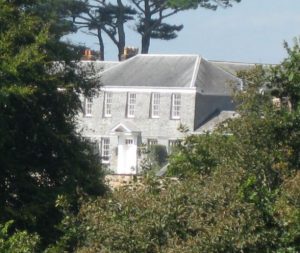 When the lease on Menabilly finally expired in 1969 she moved to another house (originally the dower house of Menabilly) rented to her by the Rashleigh family, Kilmarth, just north of Polkerris, where she died in 1989. Her ashes were scattered off the cliffs nearby, where we have just been walking. It was Daphne’s belief that she would join her dead husband in a boat sailing them to infinity.
When the lease on Menabilly finally expired in 1969 she moved to another house (originally the dower house of Menabilly) rented to her by the Rashleigh family, Kilmarth, just north of Polkerris, where she died in 1989. Her ashes were scattered off the cliffs nearby, where we have just been walking. It was Daphne’s belief that she would join her dead husband in a boat sailing them to infinity.
We catch a glimpse of Kilmarth as we head into Polkerris. The village was Poldrea in ‘Rule Britannia’, Daphne du Maurier’s last novel, published in 1972.
Tregaminion Chapel (key from the village)
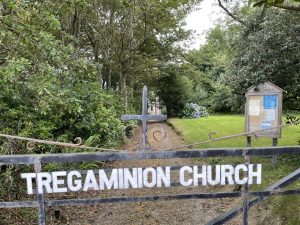
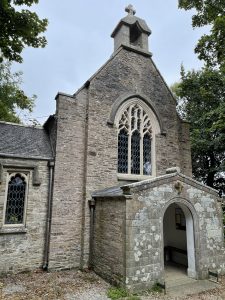
Depending on the time of year, as you walk towards this chapel, you may be treated to a rare glimpse of Menabilly. The house is usually hidden from the outside world by trees.
The private chapel was built by William Rashleigh in 1816 as a memorial to Rachel his wife. His family coat of arms is incorporated above the porch. Of course, the Rachel of my Cousin Rachel ‘lived’ in Menabilly too.
It was a very fitting place for Daphne du Maurier’s memorial service, which was held here in 1989, no doubt her choice. The chapel was filled with white camellias, Daphne’s favourite flower. This spot is at the epicentre of her landscape, mid-way between the two homes she spent so much of her life in.
We finish the walk by coming back along the ancient Saints’ Way to Fowey, following the probable route of early Christian travellers making their way from Ireland and Wales to Brittany and the European mainland.
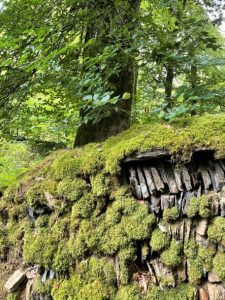
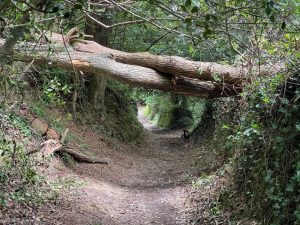
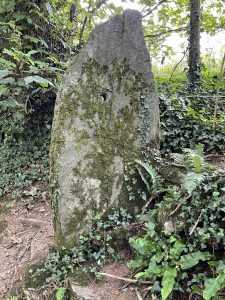 OTHER STUFF
OTHER STUFF
- Read: ‘Growing Pains’ (1977), Daphne Du Maurier’s autobiography (re-published as ‘Myself When Young: The Shaping Of A Writer’)
- Read: ‘Vanishing Cornwall’ by Daphne Du Maurier (1967)
- Browse: Shrew Books, 4 South St, Fowey PL23 1AR, https://www.shrewbooks.co.uk/. A delightful curation of books, strong on local interest titles and children’s books
- Attend: the Daphne du Maurier Festival, held every May, a week-long celebration of local plays, walks and celebrity talks –https://www.foweyfestival.com/
- Watch: ‘Rebecca’ (1940 & 2020)
- Watch: ‘My Cousin Rachel’ (2017)
- Stay: on The Menabilly Estate, at Polridmouth Cottage or Keeper’s Cottage, menabilly.com
- Visit: the Fowey Museum, which includes an exhibition dedicated to Daphne du Maurier.
- Stay: in the remote Watch House, the only building on a 7 mile stretch of cliffs between Polruan and Polperro. Daphne du Maurier had romantic trysts here with Christopher Puxley. www.hideawayhuts.co.uk/accommodation/the-watch-house/
DIRECTIONS
Walk 1: Pont Pill walk
- Set out northeast from Whitehouse Quay along the Esplanade, turning right down towards the Market Square and then continuing along Fore St, following the main shopping street through the town until it swings left into Caffamill Cove.
- Take the regular car ferry across the estuary, then climb up Hall Terrace, past the Old Ferry Inn on your right and St John’s Church on the right.
- Shortly turn right up a track marked Hall walk, through a gate with an NT emblem on it onto a path with panoramic views of the estuary, past the war memorial and the Q memorial, following the well-defined path all the way until it drops down into Pont Creek and a bridge over the stream.
- Climb up the hill on the other side and you will soon see a path marked right to Polruan. Before you take this route, you may want to head further up the hill first to visit Lanteglos (St Wyllow) Church, then re-tace your steps to here
- Take the path marked to Polruan (not marked as a path on Ordnance Survey, which takes you all the way to Polruan, and you will find yourself deposited in Fore St, from which it is a short descent to the harbour and the passenger ferry back to Whitehouse Quay (take a short diversion along West St to see the Blockhouse).
Walk 2: Menabilly & Polkerris walk
- Set out from Readymoney Cove uphill, taking the first left along the coast path and then right along Southground Cliffs, eventually reaching Polridmouth Bay; from here the path climbs steeply to the Gribbin Tower, which affords a fine view
- From the Gribbin Tower, head along the track northwestwards to shortly re-join the coast path which takes you the whole way to Polkerris
- from the quay, take the road leading out of the village, and then turn right at Penellick to join the Saints’ Way, following the small road until you reach Tregaminion Church; just before the church, take the track on your left, and follow the Saints’ way as it winds its way back to Readmoney Cove.

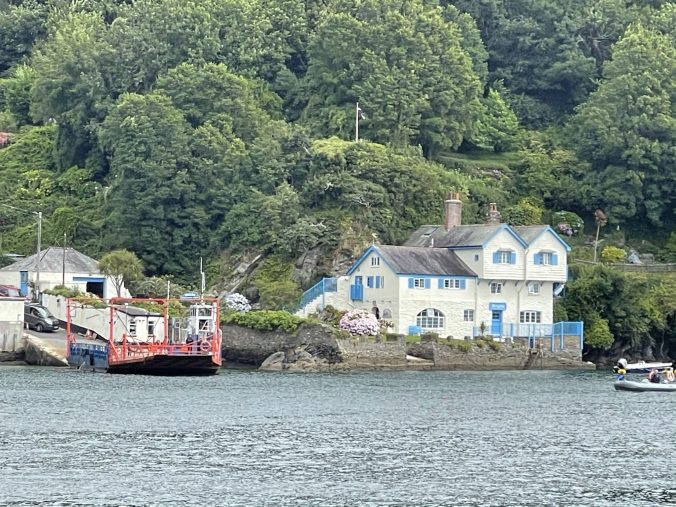
Leave a Reply